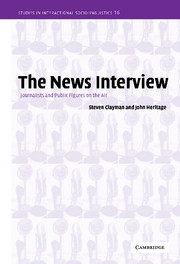Book contents
- Frontmatter
- Contents
- Acknowledgments
- 1 Introduction
- 2 The news interview in context: institutional background and historical development
- 3 Openings and closings
- 4 Basic ground rules: taking turns and “doing” news interview talk
- 5 Defensible questioning: neutralism, credibility, legitimacy
- 6 Adversarial questioning: setting agendas and exerting pressure
- 7 Answers and evasions
- 8 The panel interview: discussion and debate among interviewees
- 9 Conclusion
- Appendix: transcript symbols
- References
- Subject index
- Index of names
8 - The panel interview: discussion and debate among interviewees
Published online by Cambridge University Press: 23 November 2009
- Frontmatter
- Contents
- Acknowledgments
- 1 Introduction
- 2 The news interview in context: institutional background and historical development
- 3 Openings and closings
- 4 Basic ground rules: taking turns and “doing” news interview talk
- 5 Defensible questioning: neutralism, credibility, legitimacy
- 6 Adversarial questioning: setting agendas and exerting pressure
- 7 Answers and evasions
- 8 The panel interview: discussion and debate among interviewees
- 9 Conclusion
- Appendix: transcript symbols
- References
- Subject index
- Index of names
Summary
Thus far we have concentrated on the dynamics of interplay between interviewers and interviewees, which is the essence of the news interview in its classic form. However, the contemporary form frequently involves a panel of participating interviewees offering a variety of perspectives on some newsworthy topic. Often such panels are comprised of just two ideologically opposed interviewees who informally debate the issue. In the panel interview format, there is interplay not only between interviewers and interviewees, but also – directly or indirectly – between the interviewees themselves.
The typical panel interview attracts a less distinguished cadre of participants. While presidents, prime ministers, and senior cabinet officials are periodically interviewed solo, they rarely participate in panel discussions or debates. This selectivity is not difficult to understand. If one is sufficiently newsworthy to be the exclusive focus of attention in an interview (or better yet in a press conference involving dozens of reporters), then why share the spotlight with – and by implication lower oneself to the level of – one's political opponents? Thus, legislators, certified experts of various stripes, and representatives of advocacy groups are the mainstay of the panel interview. Consequently, rather than featuring the first-hand reflections of prominent movers and shakers, such interviews often consist of expert analysis and commentary on current events.
- Type
- Chapter
- Information
- The News InterviewJournalists and Public Figures on the Air, pp. 299 - 336Publisher: Cambridge University PressPrint publication year: 2002



